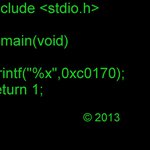The official Mbed 2 C/C++ SDK provides the software platform and libraries to build your applications.
Dependents: hello SerialTestv11 SerialTestv12 Sierpinski ... more
mbed 2
This is the mbed 2 library. If you'd like to learn about Mbed OS please see the mbed-os docs.
TARGET_EFM32PG_STK3401/TOOLCHAIN_ARM_MICRO/sl_trng.h
- Committer:
- AnnaBridge
- Date:
- 2019-02-20
- Revision:
- 172:65be27845400
- Parent:
- 171:3a7713b1edbc
File content as of revision 172:65be27845400:
/**
* \file sl_trng.h
*
* \brief True Random Number Generator (TRNG) driver for Silicon Labs devices
*
* Copyright (C) 2016, Silicon Labs, http://www.silabs.com
* SPDX-License-Identifier: Apache-2.0
*
* Licensed under the Apache License, Version 2.0 (the "License"); you may
* not use this file except in compliance with the License.
* You may obtain a copy of the License at
*
* http://www.apache.org/licenses/LICENSE-2.0
*
* Unless required by applicable law or agreed to in writing, software
* distributed under the License is distributed on an "AS IS" BASIS, WITHOUT
* WARRANTIES OR CONDITIONS OF ANY KIND, either express or implied.
* See the License for the specific language governing permissions and
* limitations under the License.
*/
#ifndef SL_TRNG_H
#define SL_TRNG_H
/***************************************************************************//**
* \addtogroup sl_crypto_trng Silicon Labs True Random Number Generator Plugin
* \brief True Random Number Generator (TRNG) driver for Silicon Labs devices.
*
* \details The EFR32xG12 and EFM32xG12 and newer Silicon Labs devices contains
* a True Random Number Generator (TRNG) peripheral. The TRNG is a
* non-deterministic random number generator based on a full hardware solution.
* The TRNG contains a 64 x 32-bit FIFO for reading out random numbers.
*
* The samples from entropy source within the TRNG are monitored permanently by
* 4 built in tests that detect issues with the noise source. The tests are
* specified in NIST-800-90B and AIS31. The tests that are always checking the
* entropy source are "Repetition Count Test", "Adaptive Proportion Test
* (64-sample window)", "Adaptive Proportion Test (4096-sample window)" and
* the "AIS31 Online Test".
*
* In addition the TRNG has options for running startup tests. When these tests
* are enabled the TRNG FIFO will not contains any data before all the startup
* tests have passed. There are 4 TRNG startup tests, 3 of the tests are
* specified in NIST-800-90B. These are the "Repetition Count Test", "Adaptive
* Proportion Test (64-sample window)" and "Adaptive Proportion Test
* (4096-sample window)". The last startup test is the AIS31 startup test. By
* default when using this driver all the startup tests are enabled.
*
* \{
******************************************************************************/
#include "em_device.h"
#include <stddef.h>
/* TRNG specific error codes: */
#define SL_TRNG_ERR_BASE (0xF100E000)
/** Conditioning test failed. */
#define SL_TRNG_ERR_CONDITIONING_TEST_FAILED ((int)SL_TRNG_ERR_BASE | 0x00000001)
/** No data received in the TRNG FIFO. */
#define SL_TRNG_ERR_NO_DATA ((int)SL_TRNG_ERR_BASE | 0x00000002)
/** Repetition Count test failed. The repetition count test fails when the
* TRNG detects that the output become "stuck" on a single value for a long
* period of time. The repetition count test is described in NIST-800-90B.
*
* If an application detects this error then the TRNG should be reset. The
* repetition count test is always enabled. */
#define SL_TRNG_ERR_REPETITION_COUNT_TEST_FAILED ((int)SL_TRNG_ERR_BASE | 0x00000003)
/** Adaptive Proportion test over 64 samples failed. The adaptive proportion
* test is designed to detect a large loss of entropy that might occur as a
* result of some physical failure or environmental change affecting the
* TRNG.
*
* The test will fail when a 2 bit sample from the TRNG is repeated an
* unusual amount of times within a window of 64 bits. The adaptive
* proportion test is further described in NIST-800-90B.
*
* If an application detects this error then the TRNG should be reset. The
* adaptive proportion test over 64 samples is always enabled. */
#define SL_TRNG_ERR_ADAPTIVE_PROPORTION_TEST_64_FAILED ((int)SL_TRNG_ERR_BASE | 0x00000004)
/** Adaptive Proportion test over 4096 samples failed. The adaptive proportion
* test is designed to detect a large loss of entropy that might occur as a
* result of some physical failure or environmental change affecting the
* TRNG.
*
* The test will fail when a 2 bit sample from the TRNG is repeated an
* unusual amount of times within a window of 4096 bits. The adaptive
* proportion test is further described in NIST-800-90B.
*
* If an application detects this error then the TRNG should be reset. The
* adaptive proportion test over 4096 samples is always enabled. */
#define SL_TRNG_ERR_ADAPTIVE_PROPORTION_TEST_4096_FAILED ((int)SL_TRNG_ERR_BASE | 0x00000005)
/** AIS31 test noise alarm. The AIS31 test is designed to monitor and verify
* the statistical distribution of the random numbers from the TRNG. The test
* performs 512 consecutive 128 bit X^2 calculations with 4 bit words. The
* details of the AIS31 test can be found in the AIS31 specification.
*
* The test will fail when an unusual statistical distribution of the TRNG
* output is found.
*
* If an application detects this error then the TRNG should be reset. The
* AIS31 test is always enabled. */
#define SL_TRNG_ERR_NOISE_ALARM ((int)SL_TRNG_ERR_BASE | 0x00000006)
/** AIS31 test Preliminary Noise alarm. The preliminary noise alarms generated
* from the same AIS31 test that generates \ref SL_TRNG_ERR_NOISE_ALARM.
* The difference between a preliminary noise alarm and a noise alarm is the
* severity and the expected frequency. A preliminary noise alarm will happen
* more frequently than a noise alarm, and a preliminary noise alarm is not
* considered critical. The preliminary noise alarm is not uncommon and should
* be expected from time to time when reading data from the TRNG.
*
* If an application detects a preliminary noise alarm then the recommended
* action is to flush the TRNG FIFO, or reset the TRNG. */
#define SL_TRNG_ERR_PRELIMINARY_NOISE_ALARM ((int)SL_TRNG_ERR_BASE | 0x00000007)
#if defined(TRNG_PRESENT)
/**
* \brief Initialize TRNG context
*
* \details This function will enable the TRNG device by starting
* the device's clock, initializing the control register, perform
* soft reset and wait until data is available in the FIFO.
*
* \param ctx TRNG device to be initialized
*/
void sl_trng_init( TRNG_TypeDef *ctx );
/**
* \brief Free TRNG context
*
* \details This function will disable the TRNG peripheral by stopping
* the TRNG's clock.
*
* \param ctx TRNG device to be released
*/
void sl_trng_free( TRNG_TypeDef *ctx );
/**
* \brief Set the TRNG conditioning key
*
* \param ctx TRNG device
* \param key 128-bit AES key
*
* \return
* 0 if success. Error code if failure.
*/
int sl_trng_set_key( TRNG_TypeDef *ctx, const unsigned char *key );
/**
* \brief Poll for entropy data
*
* \details This function will read available random data from the TRNG
* FIFO and place it into the output buffer. The len parameter
* tells this function the maximum number of bytes to read.
*
* Note that the number of bytes read from the TRNG might differ
* from the number of bytes requested. If any alarms are signaled
* or the TRNG FIFO is empty then this function will return early.
*
* The return value should be used to see if the operation was
* successful of if an alarm was encountered while reading the
* FIFO. The content of the olen parameter can be used to check
* how many bytes were actually read.
*
* \param ctx TRNG context
* \param output Buffer to fill with data from the TRNG
* \param len Maximum number of bytes to fill in output buffer.
* \param olen The actual amount of bytes put into the buffer (Can be 0)
*
* \return \li 0 if no critical failures occurred,
* \li SL_TRNG_ERR_PRELIMINARY_NOISE_ALARM if a AIS31
* preliminary noise alarm was detected while reading the FIFO,
* \li SL_TRNG_ERR_NOISE_ALARM if an AIS31 noise alarm
* was detected.
* \li SL_TRNG_ERR_REPETITION_COUNT_TEST_FAILED if the
* repetition count test failed while reading the FIFO.
* \li SL_TRNG_ERR_ADAPTIVE_PROPORTION_TEST_64_FAILED if the
* adaptive proportion test over 64 samples failed while reading
* the FIFO.
* \li SL_TRNG_ERR_ADAPTIVE_PROPORTION_TEST_4096_FAILED if
* the adaptive proportion test over 4096 samples failed while
* reading from the FIFO.
*/
int sl_trng_poll( TRNG_TypeDef *ctx,
unsigned char *output,
size_t len,
size_t *olen );
/**
* \brief Execute TRNG soft reset
*
* \details This function performs a TRNG soft reset. The TRNG soft
* reset can be used to clear error conditions such as Noise
* Alarms, etc.
*
* \param ctx TRNG device
*/
void sl_trng_soft_reset( TRNG_TypeDef *ctx );
#endif /* TRNG_PRESENT */
/** \} (end addtogroup sl_crypto_trng) */
#endif /* SL_TRNG_H */
 mbed official
mbed official




